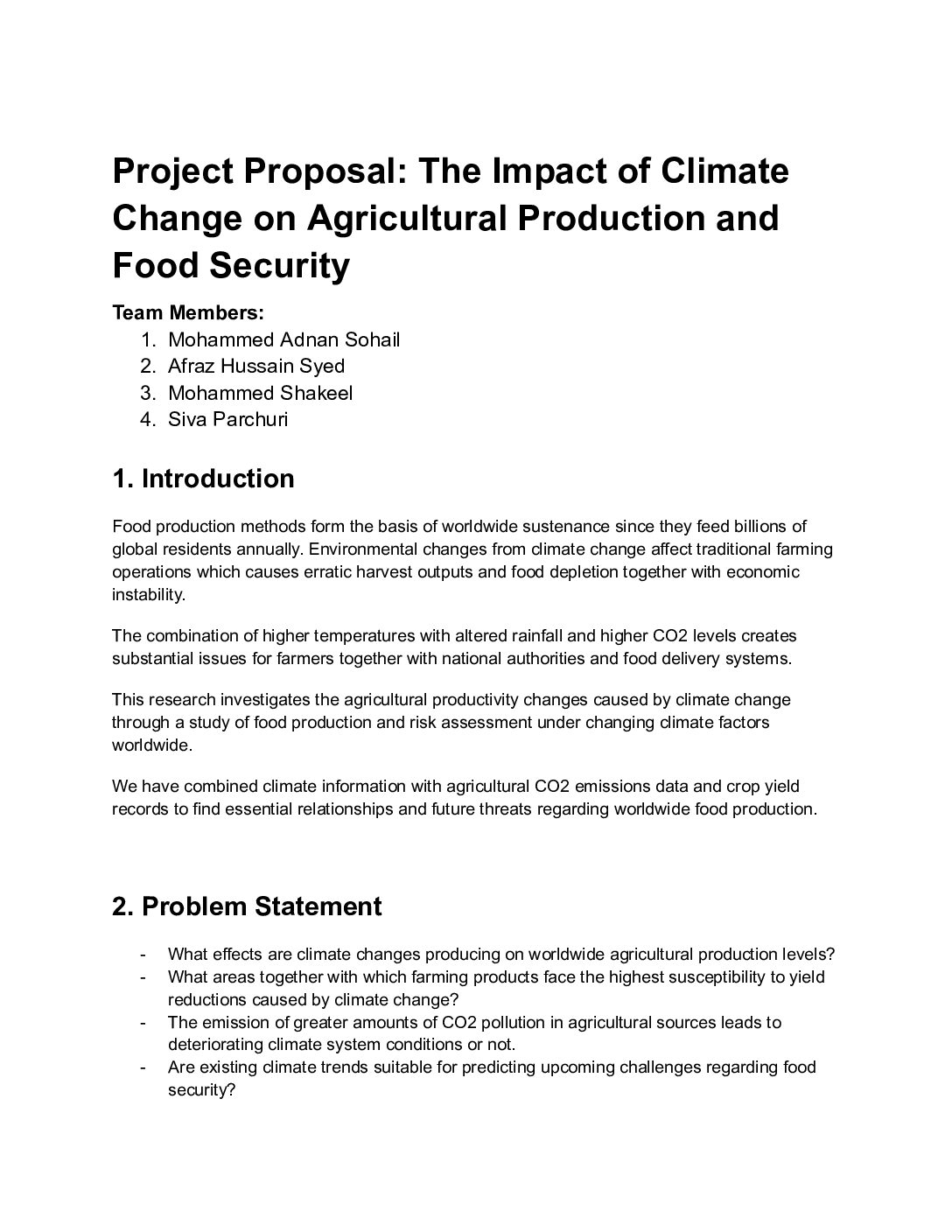Team Members:
- Mohammed Adnan Sohail
- Afraz Hussain Syed
- Mohammed Shakeel
- Siva Parchuri
1. Introduction
Food production methods form the basis of worldwide sustenance, feeding billions annually. Climate change affects traditional farming operations, causing erratic harvest outputs, food depletion, and economic instability. The combination of higher temperatures, altered rainfall, and increased CO2 levels creates substantial challenges for farmers, national authorities, and food delivery systems.
This research investigates agricultural productivity changes caused by climate change through a study of food production and risk assessment under evolving climate factors worldwide. We have combined climate information with agricultural CO2 emissions data and crop yield records to identify key relationships and future threats to global food production.
2. Problem Statement
This project aims to address the following questions:
- How does climate change impact global agricultural production levels?
- Which regions and crops are most susceptible to yield reductions due to climate change?
- Does increased CO2 pollution from agricultural sources further deteriorate climate conditions?
- Are current climate trends reliable for predicting future challenges to food security?
Through interactive data visualization and analytical tools, we aim to provide solutions for better understanding and managing these risks. The project generates data-driven insights that enable researchers, agricultural experts, and policymakers to make informed decisions regarding climate adaptation strategies.
3. About the Data
The project utilizes three major datasets sourced from Kaggle, which will be combined using country and year information as joining variables. These datasets include environmental climate data, agricultural emissions records, and crop yield modifications.
Dataset Links:
- Climate Change Dataset (2020-2024)
- Agri-Food CO2 Emission Dataset
- The Relationship Between Crop Production and Climate
Data Combination Strategy:
- Crop Yield Analysis – Assess crop yield variations against climatic data to determine how temperature and precipitation impact productivity.
- CO2 Emission Assessment – Analyze agricultural CO2 emissions to understand their carbon footprint in relation to sustainability goals.
- Regional Comparison – Examine differences in climate adaptation strategies across different regions.
4. Tools and Technologies
To analyze, visualize, and communicate our findings effectively, we will use:
- Python (Pandas, NumPy, Matplotlib, Seaborn)
- D3.js & Plotly (Interactive Visualizations)
- JavaScript & Flask (Web-based tools)
- Tableau (Data Dashboard)
5. Project Objectives
The project consists of two phases, each with specific milestones and methodologies:
Project 1: Data Exploration and Initial Insights
Understanding Climate Changes
- Conduct a systematic analysis of temperature and CO2 changes over time.
- Use heatmaps to interpret regional climate variations.
Examine Crop Production Patterns
- Compare crop yields across countries and years.
Examine Agricultural CO2 Emissions
- Identify primary CO2 emission sources such as livestock, fertilizers, and deforestation.
- Compare CO2 emissions across countries and time.
- Use scatter plots and correlation matrices to analyze how CO2 emissions influence yield efficiency.
Project 2: Interactive Data Visualization and Web Page Design
Creation of an Interactive Web Page for Data Exploration
- Utilize D3.js and Plotly for dynamic visualization.
- Implement control elements for filtering by region, crop type, and time period.
- Enable users to access and analyze researcher data interactively.
- Provide a dashboard for climate-agriculture interactions across nations.
- Include hover effects, zoom, and filtering functions for better user experience.
Showcase CO2 Emissions & Sustainability Risks
- Allow users to explore scatter plots of CO2 emissions vs. crop yield efficiency.
- Implement a live dashboard to assess policy impacts in real time.
6. Methodology and Storytelling Stages
Project 1: Data Exploration and Initial Insights
Stage 1: Exploration and Understanding
- Narration: “How has climate change evolved over the years?”
- Activity: Data cleaning, loading, and exploration.
- Visualization: Line plots for temperature, rainfall, and CO2 trends.
Stage 2: Analysis and Data Handling
- Narration: “How do agricultural and climate factors relate?”
- Activity: Handling missing values, merging datasets, and correlation analysis.
- Visualization: Heatmaps of temperature, CO2, and agricultural yield.
Project 2: Advanced Data Analysis and Interactive Visualizations
Stage 3: Interactive Webpage Development
- Narration: “How do users experience climate-agriculture interactions?”
- Action: Designing dashboards and interactive components.
- Implementation: Using D3.js and JavaScript with a Flask backend.
Stage 4: User Interactivity and Participation
- Storytelling: “How users can access and interact with the data.”
- Features: Pop-up elements, filters, zoom functions.
- Outcome: Users can compare climate-agriculture impacts between countries.
7. Interactive Webpage Structure
Main Page: Overview & Key Findings
- Global Temperature & CO2 Trends (Interactive Line Graph)
- “Global warming trends over the last decade.”
- Year-wise temperature & CO2 trends.
- Crop Production Trends by Country (Interactive Bar Chart)
- “Which countries have experienced declining agricultural productivity?”
Inner Pages: In-Depth Analysis
- Climate Change & Agriculture:
- Heatmap of rising/falling temperatures across countries.
- Drought risk visualization.
- CO2 Emissions & Sustainable Agriculture:
- CO2 emissions vs. crop yield scatter plot.
- Policy impact simulator for sustainability scenarios.
8. Timeline (12 Weeks)
- Weeks 1-4: Data collection, cleaning, and initial exploration.
- Weeks 5-8: Detailed analysis, correlation studies, and visualization creation.
- Weeks 9-12: Webpage development, interactive visualizations, and final testing.
9. Expected Visualizations
- Line graphs for temperature & CO2 trends.
- Heatmaps for regional climate variations.
- Scatter plots for CO2 emissions vs. crop yields.
- Interactive dashboards for user engagement.
10. Impact and Applications
- Policymakers: Inform food security and climate adaptation policies.
- Farmers & Agriculturalists: Identify climate-resilient crops.
- Environmentalists & Scientists: Assess sustainability threats in agriculture.
- Market Analysts & Investors: Measure climate change implications on food markets.
11. Conclusion
- Integrates real-time climate, CO2, and agriculture trends.
- Combines machine learning with interactive visualization tools.
- Provides a user-friendly dashboard for direct data analysis.
- Addresses critical global food security and climate resilience challenges.

